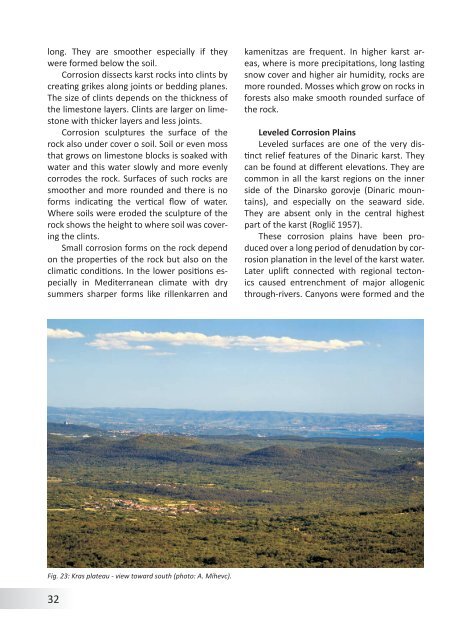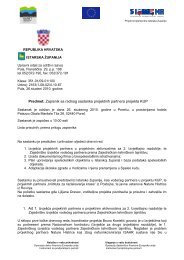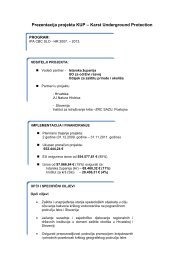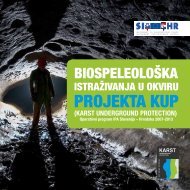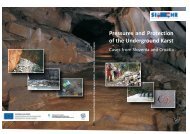Case Studies from the Dinaric Karst of Slovenia
Case Studies from the Dinaric Karst of Slovenia
Case Studies from the Dinaric Karst of Slovenia
You also want an ePaper? Increase the reach of your titles
YUMPU automatically turns print PDFs into web optimized ePapers that Google loves.
long. They are smoo<strong>the</strong>r especially if <strong>the</strong>ywere formed below <strong>the</strong> soil.Corrosion dissects karst rocks into clints bycreating grikes along joints or bedding planes.The size <strong>of</strong> clints depends on <strong>the</strong> thickness <strong>of</strong><strong>the</strong> limestone layers. Clints are larger on limestonewith thicker layers and less joints.Corrosion sculptures <strong>the</strong> surface <strong>of</strong> <strong>the</strong>rock also under cover o soil. Soil or even mossthat grows on limestone blocks is soaked withwater and this water slowly and more evenlycorrodes <strong>the</strong> rock. Surfaces <strong>of</strong> such rocks aresmoo<strong>the</strong>r and more rounded and <strong>the</strong>re is n<strong>of</strong>orms indicating <strong>the</strong> vertical flow <strong>of</strong> water.Where soils were eroded <strong>the</strong> sculpture <strong>of</strong> <strong>the</strong>rock shows <strong>the</strong> height to where soil was covering<strong>the</strong> clints.Small corrosion forms on <strong>the</strong> rock dependon <strong>the</strong> properties <strong>of</strong> <strong>the</strong> rock but also on <strong>the</strong>climatic conditions. In <strong>the</strong> lower positions especiallyin Mediterranean climate with drysummers sharper forms like rillenkarren andkamenitzas are frequent. In higher karst areas,where is more precipitations, long lastingsnow cover and higher air humidity, rocks aremore rounded. Mosses which grow on rocks inforests also make smooth rounded surface <strong>of</strong><strong>the</strong> rock.Leveled Corrosion PlainsLeveled surfaces are one <strong>of</strong> <strong>the</strong> very distinctrelief features <strong>of</strong> <strong>the</strong> <strong>Dinaric</strong> karst. Theycan be found at different elevations. They arecommon in all <strong>the</strong> karst regions on <strong>the</strong> innerside <strong>of</strong> <strong>the</strong> Dinarsko gorovje (<strong>Dinaric</strong> mountains),and especially on <strong>the</strong> seaward side.They are absent only in <strong>the</strong> central highestpart <strong>of</strong> <strong>the</strong> karst (Roglič 1957).These corrosion plains have been producedover a long period <strong>of</strong> denudation by corrosionplanation in <strong>the</strong> level <strong>of</strong> <strong>the</strong> karst water.Later uplift connected with regional tectonicscaused entrenchment <strong>of</strong> major allogenicthrough-rivers. Canyons were formed and <strong>the</strong>Fig. 23: Kras plateau - view toward south (photo: A. Mihevc).32


